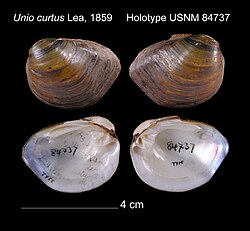Biology:Pleurobema curtum: Difference between revisions
(linkage) |
(fix) |
||
| Line 1: | Line 1: | ||
{{short description|Species of mollusc}} | {{short description|Species of mollusc}} | ||
{{Speciesbox | {{Speciesbox | ||
|image=NMNH-UniocurtusHolotypeUSNM84737.jpg | |image=NMNH-UniocurtusHolotypeUSNM84737.jpg | ||
| Line 13: | Line 12: | ||
}} | }} | ||
'''''Pleurobema curtum''''', the '''black clubshell''' or '''Curtus's mussel''', is a [[Biology:Species|species]] of freshwater mussel, an aquatic bivalve mollusk in the family [[Biology:Unionidae|Unionidae]], the river mussels. | '''''Pleurobema curtum''''', the '''black clubshell''' or '''Curtus's mussel''', is a [[Biology:Species|species]] of freshwater mussel, an aquatic [[Biology:Bivalve|bivalve]] mollusk in the family [[Biology:Unionidae|Unionidae]], the river mussels. It is a federally listed [[Biology:Endangered species|endangered species]]. | ||
This species is [[Biology:Endemism|endemic]] to the United States. | This species is [[Biology:Endemism|endemic]] to the United States, and historically occurred in the Tombigbee River in Alabama and Mississippi. At the time of its endangered listing in 1987, only two live individuals were known to have been ever collected, and populations were limited to the East Fork.<ref name="fws listing">{{cite report|url=https://www.govinfo.gov/content/pkg/FR-1987-04-07/pdf/FR-1987-04-07.pdf#page=152|title=End. Status for Marshall's Mussel (Pleurobema marshalii), Curtus' Mussel (Pleurobema curtum), Judge Tait's Mussel (Pleurobema taitianum), Stirrup Shell (Quadrual stapes), & Penitent Mussel (Epioblasma (=Dysnomia) penita); 52 FR 11162-11169|author=US Fish and Wildlife Service|date=1987}}</ref> | ||
It is a small mussel usually around {{convert|50|mm}} long, subtriangular in shape, and inflated in front. Younger shells are green, while older ones are a dark greenish-brown.<ref name="fws listing"/> | |||
The species was likely adversely affected by impoundments on the Tombigbee River and construction of the Tennessee-Tombigbee Waterway in 1985, which altered water flow, increased siltation, and disturbed habitat by dredging.<ref name="fws listing"/> No living specimens have been found since construction of the waterway. Fresh dead shells were found in 1997 on a single shoal in the East Fork Tombigbee River in Itawamba County, Mississippi, and further surveys have been unsuccessful. As of the latest 5-year review by US Fish and Wildlife Service in 2021, no recent searches had been made, and it is possible the species still persists.<ref name="5-year 2021">{{cite report|url=https://ecosphere-documents-production-public.s3.amazonaws.com/sams/public_docs/species_nonpublish/3478.pdf|title=Black Clubshell (Pleurobema curtum), Heavy Pigtoe (Pleurobema taitianum), Southern Combshell (Epioblasma penita) 5-Year Review 2021|author=US Fish and Wildlife Service|date=2021}}</ref> | |||
==References== | ==References== | ||
Latest revision as of 07:45, 22 June 2025
| Pleurobema curtum | |
|---|---|

| |
| Scientific classification | |
| Domain: | Eukaryota |
| Kingdom: | Animalia |
| Phylum: | Mollusca |
| Class: | Bivalvia |
| Order: | Unionida |
| Family: | Unionidae |
| Genus: | Pleurobema |
| Species: | P. curtum
|
| Binomial name | |
| Pleurobema curtum (I. Lea, 1859)
| |
| Synonyms[2] | |
| |
Pleurobema curtum, the black clubshell or Curtus's mussel, is a species of freshwater mussel, an aquatic bivalve mollusk in the family Unionidae, the river mussels. It is a federally listed endangered species.
This species is endemic to the United States, and historically occurred in the Tombigbee River in Alabama and Mississippi. At the time of its endangered listing in 1987, only two live individuals were known to have been ever collected, and populations were limited to the East Fork.[3]
It is a small mussel usually around 50 millimetres (2.0 in) long, subtriangular in shape, and inflated in front. Younger shells are green, while older ones are a dark greenish-brown.[3]
The species was likely adversely affected by impoundments on the Tombigbee River and construction of the Tennessee-Tombigbee Waterway in 1985, which altered water flow, increased siltation, and disturbed habitat by dredging.[3] No living specimens have been found since construction of the waterway. Fresh dead shells were found in 1997 on a single shoal in the East Fork Tombigbee River in Itawamba County, Mississippi, and further surveys have been unsuccessful. As of the latest 5-year review by US Fish and Wildlife Service in 2021, no recent searches had been made, and it is possible the species still persists.[4]
References
- ↑ Cummings, K.; Cordeiro, J. (2012). "Pleurobema curtum". IUCN Red List of Threatened Species 2012: e.T17666A1443222. doi:10.2305/IUCN.UK.2012-1.RLTS.T17666A1443222.en. https://www.iucnredlist.org/species/17666/1443222. Retrieved 18 November 2021.
- ↑ "Pleurobema curtum (Lea, 1859)". Integrated Taxonomic Information System. https://www.itis.gov/servlet/SingleRpt/SingleRpt?search_topic=TSN&search_value=80096.
- ↑ 3.0 3.1 3.2 US Fish and Wildlife Service (1987). End. Status for Marshall's Mussel (Pleurobema marshalii), Curtus' Mussel (Pleurobema curtum), Judge Tait's Mussel (Pleurobema taitianum), Stirrup Shell (Quadrual stapes), & Penitent Mussel (Epioblasma (=Dysnomia) penita); 52 FR 11162-11169 (Report). https://www.govinfo.gov/content/pkg/FR-1987-04-07/pdf/FR-1987-04-07.pdf#page=152.
- ↑ US Fish and Wildlife Service (2021). Black Clubshell (Pleurobema curtum), Heavy Pigtoe (Pleurobema taitianum), Southern Combshell (Epioblasma penita) 5-Year Review 2021 (Report). https://ecosphere-documents-production-public.s3.amazonaws.com/sams/public_docs/species_nonpublish/3478.pdf.
Wikidata ☰ Q3017244 entry
 |


